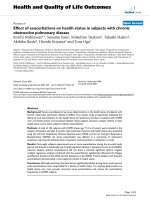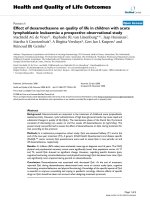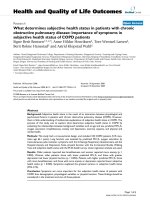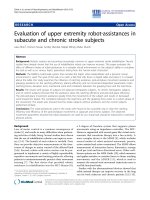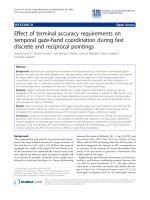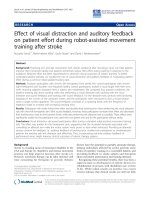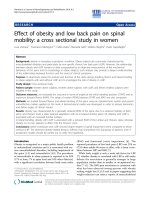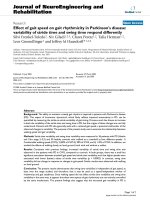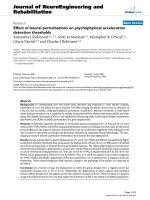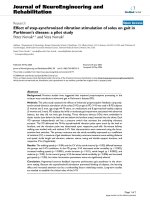báo cáo hóa học:" Effect of exacerbations on health status in subjects with chronic obstructive pulmonary disease" pdf
Bạn đang xem bản rút gọn của tài liệu. Xem và tải ngay bản đầy đủ của tài liệu tại đây (285.01 KB, 8 trang )
BioMed Central
Page 1 of 8
(page number not for citation purposes)
Health and Quality of Life Outcomes
Open Access
Research
Effect of exacerbations on health status in subjects with chronic
obstructive pulmonary disease
Koichi Nishimura*
1
, Susumu Sato
2
, Mitsuhiro Tsukino
3
, Takashi Hajiro
4
,
Akihiko Ikeda
5
, Hiroshi Koyama
6
and Toru Oga
7
Address:
1
Department of Respiratory Medicine, Murakami Memorial Hospital, Asahi University, Gifu, Japan,
2
Department of Respiratory
Medicine, Graduate School of Medicine, Kyoto University, Kyoto, Japan,
3
Department of Respiratory Medicine, Hikone Municipal Hospital,
Hikone, Japan,
4
Department of Respiratory Medicine, Tenri Hospital, Tenri, Japan,
5
Department of Respiratory Medicine, Nishi-Kobe Medical
Center, Kobe, Japan,
6
General Internal Medicine, National Hospital Organization Kyoto Medical Center, Kyoto, Japan and
7
Department of
Respiratory Care and Sleep Control Medicine, Graduate School of Medicine, Kyoto University, Kyoto, Japan
Email: Koichi Nishimura* - ; Susumu Sato - ; Mitsuhiro Tsukino - tsukino@municipal-
hp.hikone.shiga.jp; Takashi Hajiro - ; Akihiko Ikeda - ;
Hiroshi Koyama - ; Toru Oga -
* Corresponding author
Abstract
Background: Acute exacerbations may cause deteriorations in the health status of subjects with
chronic obstructive pulmonary disease (COPD). The present study prospectively evaluated the
effects of such exacerbations on the health status and pulmonary function of subjects with COPD
over a 6-month period, and examined whether those subjects showed a steeper decline in their
health status versus those subjects without exacerbations.
Methods: A total of 156 subjects with COPD (mean age 71.4 ± 6.3 years) were included in the
analysis. At baseline and after 6 months, their pulmonary function and health status were evaluated
using the Chronic Respiratory Disease Questionnaire (CRQ) and the St. George's Respiratory
Questionnaire (SGRQ). An acute exacerbation was defined as a worsening of respiratory
symptoms requiring the administration of systemic corticosteroids or antibiotics, or both.
Results: Forty-eight subjects experienced one or more exacerbations during the 6-month study
period, and showed a statistically and clinically significant decline in Symptom scores on the SGRQ,
whereas subjects without exacerbations did not show a clinically significant decline. Logistic
multiple regression analyses confirmed that the exacerbations significantly influenced the Fatigue
and Mastery domains of the CRQ, and the Symptoms in the SGRQ. Twelve subjects with frequent
exacerbations demonstrated a more apparent decline in health status.
Conclusion: Although pulmonary function did not significantly decline during the 6-month period,
acute exacerbations were responsible for a decline in health status. To minimize deteriorations in
health status, one must prevent recurrent acute exacerbations and reduce the exacerbation
frequencies in COPD subjects.
Published: 22 July 2009
Health and Quality of Life Outcomes 2009, 7:69 doi:10.1186/1477-7525-7-69
Received: 3 September 2008
Accepted: 22 July 2009
This article is available from: />© 2009 Nishimura et al; licensee BioMed Central Ltd.
This is an Open Access article distributed under the terms of the Creative Commons Attribution License ( />),
which permits unrestricted use, distribution, and reproduction in any medium, provided the original work is properly cited.
Health and Quality of Life Outcomes 2009, 7:69 />Page 2 of 8
(page number not for citation purposes)
Background
Acute exacerbations are associated with considerable
symptomatic and physiological deterioration, and can
worsen the health status in subjects with chronic obstruc-
tive pulmonary disease (COPD) [1,2]. Seemungal et al. [3]
reported that subjects with frequent COPD exacerbations
during the preceding year had significantly higher St.
George's Respiratory Questionnaire (SGRQ) [4] scores
than those with less frequent exacerbations. Assessments
during acute exacerbations demonstrated that the health
status worsened relative to subjects with stable COPD [4-
12], and that the recovery period was longer, even in sub-
jects without further exacerbations, since a single exacer-
bation has a sustained effect on health status [7]. Inhaled
corticosteroids (ICS) reduced the frequency of acute exac-
erbations and also reduced the rate of decline in the
health status, since frequent exacerbations were associated
with a more rapid rate of deterioration in health status
[13-15]. Furthermore, several studies [8-12,16,17]
showed that exacerbations were associated with a signifi-
cant worsening in the health status of subjects with COPD
as measured by SGRQ scores.
Since acute COPD exacerbations could accelerate the
decline in health status in stable COPD subjects, and these
subjects with exacerbations would show a steeper decline
in health status versus subjects without exacerbations.
Therefore, the present study prospectively evaluated the
effects of exacerbations on the health status and pulmo-
nary function of subjects with COPD over a 6-month
period. The health status was measured by two widely-
used disease-specific questionnaires, the Chronic Respira-
tory Disease Questionnaire (CRQ) [18] and the SGRQ[4].
Methods
Subjects
A total of 156 consecutive subjects with COPD (149
males) were enrolled in this study from the Kyoto Univer-
sity Hospital outpatient clinic from October 1999 to
March 2000. The entry criteria for this study were as fol-
lows: (1) a clinical diagnosis of stable COPD as defined by
the American Thoracic Society [19]; (2) a maximal forced
expiratory volume in one second (FEV
1
) <80% of the pre-
dicted value for all measurements made during the previ-
ous 6 months; (3) a maximal FEV
1
/forced vital capacity
(FVC) ratio <0.7; (4) a smoking history >20 pack-years;
(5) prior, regular treatment at our clinic for more than 6
months; (6) no exacerbations of airflow limitation over
the preceding 6 weeks; (7) no history suggestive of
asthma; and (8) no severe comorbidities.
An acute exacerbation was defined as a worsening of res-
piratory symptoms that required treatment with oral cor-
ticosteroids or antibiotics, or both [13,14]. Pulmonary
function tests, blood gas analyses, and health status were
measured on the same day at baseline, and again after 6
months when the subjects were stable. If an exacerbation
occurred on the second evaluation day after 6 months,
then the subjects were rescheduled for another evaluation
at 6 weeks after the development of respiratory infections
or exacerbations. All measurements were performed after
a 6-week exacerbation-free period. All subjects attended
the second visit, and were considered to be valid.
Pulmonary function tests
Inhaled bronchodilators were withheld for at least 12 h
before the pulmonary function tests. All spirometric flow-
volume curves for determining the FEV
1
and FVC were
recorded according to the methods described in the Amer-
ican Thoracic Society 1994 update [20], using a spirome-
ter (AUTOSPIRO AS-600, Minato Medical Science Co.
Ltd., Osaka, Japan) which was calibrated with a 3.0 L
syringe. The FEV
1
and FVC were assessed before, and at 15
and 60 minutes after the inhalation of bronchodilators
(80 μg of ipratropium bromide plus 400 μg of salbuta-
mol), using a metered-dose inhaler with a spacer device
(InspirEase
®
; Schering-Plough K. K., Osaka, Japan). Except
for the FEV
1
and FVC, all pulmonary function tests were
performed with a Chestac-55V (Chest MI Corp., Tokyo,
Japan) before bronchodilation. The residual volumes
(RV) and total lung capacity (TLC) were measured by a
helium dilution method. The carbon monoxide transfer
coefficient (K
CO) was measured by the single-breath
method. The predicted values for the pulmonary function
measurements were calculated according to the Japan
Society of Chest Diseases' proposal [21]. The partial pres-
sures of arterial oxygen (PaO
2
) and carbon dioxide
(PaCO
2
) were measured at rest using a blood gas analyzer
(ABL 620, Radiometer Medical A/S, Copenhagen, Den-
mark).
Health status assessments
The health status of each subject was assessed by two
major, previously-validated Japanese versions of [22], dis-
ease-specific questionnaires: the CRQ [18] and SGRQ [4].
The two questionnaires were self-administered at base-
line, and again after 6 months under the supervision of
the investigators, in the same order, in booklet form. An
investigator (T.O.) reviewed the surveys to ensure that the
subjects did not unintentionally omit questions.
The CRQ consists of 20 items and four domains (Dysp-
nea, Fatigue, Emotional function, and Mastery), and each
question was presented as a seven-point scale [18]. Each
domain of the CRQ was scored as the sum of these points,
and higher scores represent a better health status. The total
score, as represented by the sum of the scores from these
four domains, was also calculated. A change in score of
0.5 points per question is consistent with a clinically sig-
nificant change in the subject [23].
Health and Quality of Life Outcomes 2009, 7:69 />Page 3 of 8
(page number not for citation purposes)
The SGRQ consists of 50 items and three components
(Symptoms, Activity, and Impacts) [4]. The three compo-
nents of the SGRQ were transformed into a score from 0
to 100. Higher scores indicate a poorer health status. A
change in the score of 4 units is consistent with a clinically
significant change in the subject [24].
Statistical analyses
Statistical analyses were performed using SPSS 6.1 soft-
ware (SPSS Institute, Chicago, IL). The results are pre-
sented as means ± SD, unless otherwise stated.
Comparisons of continuous variables between subjects
with exacerbations versus without exacerbations were per-
formed using t tests, and discrete variables were compared
using Chi-square tests. Data that were not normally dis-
tributed were subjected to a Mann-Whitney U test. Com-
parisons of changes in physiological parameters were
analyzed by a paired t test. Wilcoxon sign-rank tests were
used to compare changes in the health status. We per-
formed stepwise multiple regression analyses to predict
the changes in each health status score. Furthermore, we
also performed stepwise multiple logistic regression anal-
yses to identify the influence of risk factors (including
acute exacerbations) on the health status deterioration,
which was defined as exceeding the minimal significant
differences (0.5 units per question for the CRQ and 4
units for the SGRQ). In both regression analyses, the inde-
pendent variables included the frequency of acute exacer-
bation, age, pulmonary function (FEV
1
, KCO, and RV/
TLC) at baseline, smoking status (current smoking = "1",
and former smoking = "0"), and each baseline score of the
relevant domain. The significance level of all analyses was
set at 5%.
Results
The patient characteristics and health status at baseline are
presented in Table 1. The mean age of all subjects was 71.4
years, with a mean pre-bronchodilator FEV
1
of 0.97 L
(38.1% predicted). Twenty-eight subjects were current
smokers at baseline. One hundred fifty-four (98.7%) sub-
jects regularly received an inhaled bronchodilator (anti-
cholinergic agent and beta-2 agonist), and seventy-nine
(50.6%) subjects received additional high dose ICS
(beclomethasone dipropionate) at 1600 μg daily, and
nine (5.8%) subjects also received oral corticosteroids at
baseline. Two subjects were managed with long-term
domiciliary oxygen therapy. All subjects visited our outpa-
tient clinic for regular examinations.
Table 1: Characteristics and health status of COPD subjects at baseline according to the exacerbation status during the 6-month
follow-up*
With exacerbation
(n = 48)
Without exacerbation
(n = 108)
P value
Gender (M/F) 46/2 103/5 0.90
Age, yrs 71.4 ± 7.0 71.4 ± 6.0 0.95
pre-bronchodilator FEV
1
, L 0.83 ± 0.22 1.04 ± 0.37 < 0.001
pre-bronchodilator FEV
1
, %pred. 32.8 ± 9.1 40.5 ± 13.3 <0.001
pre-bronchodilator FVC, L 2.06 ± 0.42 2.26 ± 0.66 0.049
post-bronchodilator FEV
1
, L 1.04 ± 0.26 1.26 ± 0.43 <0.001
post-bronchodilator FEV
1
, %pred. 40.7 ± 10.9 49.3 ± 15.4 <0.001
post-bronchodilator FVC, L 2.50 ± 0.46 2.67 ± 0.66 0.10
Current/former-smokers 10/38 18/90 0.53
Using inhaled corticosteroids, % 54.2 49.1 0.57
TLC, L 5.78 ± 0.88 5.60 ± 1.00 0.28
RV/TLC, % 50.4 ± 7.3 47.0 ± 8.7 0.02
K
CO
, mmol·min
-1
·kPa
-1
·L
-1
0.83 ± 0.38 0.99 ± 0.39 0.02
PaO
2
, kPa 9.71 ± 1.20 9.81 ± 1.17 0.62
PaCO
2
, kPa 5.48 ± 0.41 5.40 ± 0.52 0.37
CRQ**
Dyspnea (5–35) 25.4 ± 5.4 27.0 ± 5.2 0.09
Fatigue (4–28) 19.0 ± 5.3 20.3 ± 5.4 0.19
Emotion (7–49) 37.4 ± 8.5 39.4 ± 8.6 0.18
Mastery (4–28) 22.0 ± 4.4 22.4 ± 4.6 0.60
Total (20–140) 103.8 ± 20.2 109.0 ± 20.3 0.14
SGRQ (0–100)
†
Symptoms 53.7 ± 20.7 45.2 ± 22.8 0.03
Activity 54.4 ± 19.8 43.1 ± 23.3 0.003
Impacts 32.8 ± 18.9 26.9 ± 19.1 0.08
Total score 44.5 ± 17.7 36.2 ± 19.4 0.013
* The data are presented as mean ± SD unless otherwise stated. ** Higher scores indicate a better quality of life on the CRQ. † Higher scores
indicate a poorer health status on the SGRQ.
Health and Quality of Life Outcomes 2009, 7:69 />Page 4 of 8
(page number not for citation purposes)
Forty-eight (30.8%) subjects had one or more exacerba-
tions during the 6-month study period. Twelve of these
subjects (25.0%) had two or more exacerbations. A total
of 64 exacerbations were identified. The mean frequency
of exacerbations was estimated at 0.82 per subject per
year.
At baseline, those subjects with exacerbations showed a
significantly higher RV/TLC and lower pre-bronchodilator
FEV
1
, post-bronchodilator FEV
1
, pre-bronchodilator FVC,
and K
CO values than those subjects without exacerbations
(Table 1). Subjects with exacerbations also showed a sig-
nificantly worse health status in the Symptoms, Activity
and total scores on the SGRQ than subjects without exac-
erbations (Table 1). Seventy-nine subjects were on ICS,
and acute exacerbations occurred in 26 of these subjects
(32.9%). On the other hand, 77 subjects were not taking
ICS, and exacerbations occurred in 22 of these subjects
(28.5%). Logistic regression analysis revealed that ICS did
not influence the exacerbations (odds ratio = 1.07,
95%CI; 0.71–1.61). From an analysis of the baseline data
obtained from the SGRQ, on the second question regard-
ing phlegm, twenty-five subjects had chronic phlegm on
"several" or "most days" per week, and eight of them
(32%) had exacerbations. This rate of exacerbation was
not significantly different from subjects without symp-
toms suggestive of chronic bronchitis. There were no sig-
nificant differences between subjects with and without
exacerbations in terms of age, arterial blood gas tension,
or the proportion of subjects currently smoking.
Figures 1 and 2 showed the changes in the health status of
each group of subjects. In subjects without exacerbations,
statistically significant (p < 0.05) declines in health status
were observed in two domains (Dyspnea and Emotion),
the total scores of the CRQ and in the Activity scores of the
SGRQ. In subjects with exacerbations, statistically signifi-
cant declines in health status were observed in three
domains (Fatigue, Emotion, and Mastery), the total scores
of the CRQ and the Symptoms scores of the SGRQ. Sub-
jects with exacerbations showed a clinically significant
decline (>4 units) during the 6-month study period in
their SGRQ Symptom scores. In those subjects with exac-
erbations, the spirometric values and arterial blood gas
tension did not change significantly over the 6-month
study period. In those without exacerbations, only small
but significant declines in spirometric values were
observed (post-bronchodilator FEV
1
and pre-bronchodi-
lator FVC between-subject comparisons, both p values =
0.04). However, these differences were not statistically sig-
nificant after adjusting for physical constitution.
The results from the stepwise multiple regression analyses
used to predict the changes in health status scores are pre-
sented as determinations of coefficients (R
2
) (Additional
file 1, Table S1). The baseline scores from each subscale
significantly predicted the subsequent changes in each
score, except for the total score of the CRQ. Following the
baseline scores, the frequency of exacerbations signifi-
cantly accounted for the changes in the Mastery of the
CRQ (R
2
= 0.03) and the Symptoms of the SGRQ (R
2
=
0.05), and the RV/TLC accounted for the changes in the
Impacts of the SGRQ (R
2
= 0.03).
The results from logistic regression analyses are presented
(Additional file 1, Table S2) as adjusted odds ratios, which
may be interpreted as measurements of independent rela-
Changes in the CRQ scores over 6 months in subjects with (open bars) and without acute exacerbations (gray bars)Figure 1
Changes in the CRQ scores over 6 months in subjects
with (open bars) and without acute exacerbations
(gray bars). Mean scores ± SE in comparison to the baseline
are presented. The broken line indicates a clinically significant
deterioration in health status. A lower score indicates a dete-
rioration in health status *: p < 0.05 versus baseline.
Changes in the SGRQ scores over 6 months in subjects with (open bars) and without acute exacerbations (gray bars)Figure 2
Changes in the SGRQ scores over 6 months in sub-
jects with (open bars) and without acute exacerba-
tions (gray bars). Mean scores ± SE in comparison to the
baseline are presented. The broken line indicates a clinically
significant deterioration in health status. A higher score indi-
cates a deterioration in health status.*: p < 0.05 versus base-
line.
Health and Quality of Life Outcomes 2009, 7:69 />Page 5 of 8
(page number not for citation purposes)
tive risk factors. The number of subjects whose change
score exceeded the MCID was 43 (Dyspnea), 59 (Fatigue),
48 (Emotion), 58 (Mastery) and 39 (Total) on the CRQ,
and 68 (Symptoms), 71 (Activity), 46 (Impacts) and 51
(Total) on the SGRQ. An increase in the occurrence of an
acute exacerbation, in other words additional exacerba-
tions, caused a significant deterioration in the health sta-
tus in the Fatigue (odds ratio (OR) = 1.77, p = 0.02) and
Mastery (OR = 1.92, p = 0.01) domains of the CRQ, and
in the Symptom scores (OR = 2.11, p = 0.01) in the SGRQ.
Only the SGRQ Symptom scores with worse baseline
scores showed a significant influence on the decline in
health status (OR = 0.97, p < 0.001). Thus, the above two
types of regression analyses (Additional file 1, Tables S1
and S2) confirmed that the frequency of exacerbations sig-
nificantly affected the decline in health status.
Additional analyses were performed on those subjects
with frequent exacerbations. Subjects with two or more
exacerbations (n = 12) showed clinically significant
declines in health status in the Fatigue, Emotion and Mas-
tery domains of the CRQ (-0.54, -0.54, and -0.60/ques-
tion, respectively) (Figure 3), and in all three components
and the total score of the SGRQ (Symptoms: 12.4, Activ-
ity: 5.1, Impacts: 4.4, and total SGRQ: 6.1 units, respec-
tively) (Figure 4). Spirometric examinations showed a
decline in the pre-bronchodilator and post-bronchodila-
tor FEV
1
(0.05 ± 0.14 and 0.05 ± 0.12 L, respectively), but
these changes were not statistically significant. There were
no significant differences in the frequency of acute exacer-
bations between those subjects who received ICS and
those who did not.
Discussion
To our knowledge, this is the first study in the literature
that prospectively examines and clearly demonstrates the
influence of acute exacerbations on the health status dete-
rioration in subjects with COPD. We examined 156
COPD subjects, and found that 48 experienced exacerba-
tions during the 6-month study period. Although changes
in pulmonary function were not observed, the exacerba-
tion effects on the health status were determined to be sta-
tistically significant. Moreover, frequent exacerbations
were associated with clinically significant disturbances in
health status.
Comparisons between the baseline values and values after
6 months revealed that subjects with exacerbations
showed a 5-unit decline in the Symptom scores in the
SGRQ. In contrast, subjects without exacerbations did not
show any changes in excess of the minimal clinical signif-
icant decline (0.5 units per question for the CRQ and 4
units for the SGRQ). Multiple regression analyses con-
firmed that the exacerbations significantly predicted the
changes in the Mastery of the CRQ and Symptoms of the
SGRQ, independent of their baseline scores, and logistic
regression analyses confirmed a statistically significant
effect of the exacerbations on the health status deteriora-
tion in the Fatigue and Mastery of the CRQ and the Symp-
toms of the SGRQ. These results support our hypothesis
that subjects experiencing exacerbations would show a
steeper decline in health status than those without exacer-
bations. Despite no significant changes in the physiologi-
cal indices, including the FEV
1
, an increased frequency of
acute exacerbations was associated with a deterioration in
health status during the 6-month study period.
Changes in the CRQ scores over 6 months in subjects with-out acute exacerbations (gray bars), subjects with one exac-erbation (hatched bars), and those with two or more exacerbations (open bars)Figure 3
Changes in the CRQ scores over 6 months in subjects
without acute exacerbations (gray bars), subjects
with one exacerbation (hatched bars), and those with
two or more exacerbations (open bars). The results
are presented as means ± SE. *: p < 0.05 versus baseline.
Changes in the SGRQ scores over 6 months in subjects with-out acute exacerbations (gray bars), subjects with one exac-erbation (hatched bars), and those with two or more exacerbations (open bars)Figure 4
Changes in the SGRQ scores over 6 months in sub-
jects without acute exacerbations (gray bars), sub-
jects with one exacerbation (hatched bars), and
those with two or more exacerbations (open bars).
The results are presented as means ± SE. *: p < 0.05 versus
baseline.
Health and Quality of Life Outcomes 2009, 7:69 />Page 6 of 8
(page number not for citation purposes)
We also found that subjects who had two or more exacer-
bations showed statistically and clinically significant
declines in three domains of the CRQ (Fatigue, Emotion,
and Mastery), and in all three components and the total
scores of the SGRQ (Figure 3 &4). These results are con-
sistent with previous reports [3,15-17], which indicated
that patients with frequent exacerbations showed a poorer
health status. Spencer et al, [7] reported that a single infec-
tive exacerbation of chronic bronchitis has a large and sus-
tained effect on the health status, and although the initial
recovery is fast, the convalescence period is long even in
subjects who did not experience further exacerbations. If
recurrent exacerbations occur over a short period, then the
deterioration in health status may be enhanced. Delayed
recoveries in the health status may be cumulative, and
therefore only subjects with frequent exacerbations may
demonstrate a clinically significant decline in health sta-
tus in the present study. These results are compatible with
those from previous studies [15-17], including the ISO-
LDE study [13,14]. Exacerbations may have detrimental
and cumulative effects on health status, and thus the fre-
quency of exacerbations is a significant factor that leads to
a poor health status. Therefore, to prevent deteriorations
in the health status, it is important to prevent recurring
acute exacerbations.
The Lung Health Study [25] reported that lower respira-
tory illnesses would promote a decline in the FEV
1
in
smokers with COPD, whereas a similar effect was not
observed in sustained quitters. Donaldson et al, [26]
reported that subjects who suffered frequent exacerba-
tions experienced a significantly greater decline in their
FEV
1
than subjects who had infrequent exacerbations.
However, in the present study, the exacerbations did not
significantly influence any physiological parameters over
the 6-month period, although exacerbations had a signif-
icant effect on the long-term deterioration in health sta-
tus. Even in patients with frequent exacerbations, the FEV
1
did not show any statistically significant changes over the
6-month study period. Although the negative results in
the FEV
1
decline in the present study are likely due to the
short study period and the small number of enrolled sub-
jects, the results of the present study suggest that acute
COPD exacerbations have a more potent influence on the
long-term deterioration in health status than on pulmo-
nary function. Although the FEV
1
only weakly correlates
to health status [22], the exacerbation effects on health
status versus physiological parameters clearly differ.
This study has several limitations. Since we intended to
assess the effects of exacerbations, we established a study
interval of 6 months. Anthonisen et al. [27] reported that
the incidence of exacerbations was 1.1 per subject per
year, so we expected that almost one-half of the subjects
would have experienced an acute exacerbation during the
6-month study period. However, acute exacerbations
occurred in only 31% of the subjects. If we had estab-
lished a more prolonged study interval, then more sub-
jects may have experienced exacerbations. Second,
concerning the definition of an exacerbation, we selected
the definition of an acute exacerbation of COPD similar
to that utilized in the ISOLDE trial [14,28]. However, def-
initions of an acute exacerbation in the literature vary
[2,19,28-30], indicating that there is no clear consensus
on the definition of an exacerbation. The application of a
different definition of exacerbation may explain the lower
exacerbation rate in our study as compared to a previous
report by Seemungal et al. [3,26]. According to an article
by Burge and Wedzicha [28], the use of daily cards is rec-
ommended to prospectively ascertain acute exacerbations.
Third, there were significant differences in baseline status
between subjects with and without exacerbations. Nota-
bly, differences in the baseline health status reached min-
imal clinical significance, and may have influenced the
changes in health status. However, except for the baseline
score of the Symptoms in the SGRQ, the logistic multiple
regression analyses did not show any significant effect on
this factor, even though it was significantly different at
baseline between subjects with and without exacerba-
tions. In this analysis, we could deny the influence of dif-
ferences between each group on the physiological factors
at baseline. Indeed, the differences in the FEV
1
at baseline
may reflect higher risk factors for exacerbations in both
the health status and the physiological status, and these
results are compatible with the close relationship between
the severity of COPD and the high risk of exacerbations
shown in previous studies [31,32]. However, in the
present study, we focused on the effect of exacerbations
on the decline in health status, and therefore an analysis
to identify the risk factors for acute exacerbations was not
performed. Although only one-third of the exacerbations
have been reported, and both reported and unreported
exacerbations have an impact on health status [11,12].
The last limitation to our study is that unreported exacer-
bations were not included [11,12,33].
Conclusion
In conclusion, we demonstrated that acute exacerbations
require the use of additional medication, even in an out-
patient clinic, that could be detected statistically over a 6-
month period. Although the FEV
1
did not significantly
decline, acute COPD exacerbations were responsible for
the decline in health status. In addition, when acute exac-
erbations occur frequently, the health status deterioration
may be enhanced and may exceed the minimal clinically
significant decline in the CRQ and SGRQ scores during
the 6-month study period. It is therefore necessary to pre-
vent recurrent exacerbations in order to minimize deteri-
orations in the health status. Moreover, since the
unfavourable aspects caused by exacerbations may be
Health and Quality of Life Outcomes 2009, 7:69 />Page 7 of 8
(page number not for citation purposes)
related to health status deterioration, health-care profes-
sionals should pay special attention to the health status
scores in COPD subjects, and especially scores following
exacerbations.
Competing interests
The authors declare that they have no competing interests.
Authors' contributions
KN was a physician responsible for all the participants, set
out the study design, and prepared the final manuscript.
SS collected the data and prepared the initial manuscript.
MT, TH, AI, HK and TO participated in data collection and
the care for the participants. SS and TO performed the sta-
tistical analysis. All authors read and approved the final
manuscript.
Additional material
References
1. Pauwels RA, Buist AS, Calverley PM, Jenkins CR, Hurd SS: Global
strategy for the diagnosis, management, and prevention of
chronic obstructive pulmonary disease. NHLBI/WHO Glo-
bal Initiative for Chronic Obstructive Lung Disease (GOLD)
Workshop summary. American journal of respiratory and critical care
medicine 2001, 163(5):1256-1276.
2. Rabe KF, Hurd S, Anzueto A, Barnes PJ, Buist SA, Calverley P, Fukuchi
Y, Jenkins C, Rodriguez-Roisin R, van Weel C, et al.: Global strategy
for the diagnosis, management, and prevention of chronic
obstructive pulmonary disease: GOLD executive summary.
American journal of respiratory and critical care medicine 2007,
176(6):532-555.
3. Seemungal TA, Donaldson GC, Paul EA, Bestall JC, Jeffries DJ, Wed-
zicha JA: Effect of exacerbation on quality of life in patients
with chronic obstructive pulmonary disease. American journal
of respiratory and critical care medicine 1998, 157(5 Pt 1):1418-1422.
4. Jones PW, Quirk FH, Baveystock CM, Littlejohns P: A self-com-
plete measure of health status for chronic airflow limitation.
The St. George's Respiratory Questionnaire. The American
review of respiratory disease 1992, 145(6):1321-1327.
5. Aaron SD, Vandemheen KL, Clinch JJ, Ahuja J, Brison RJ, Dickinson G,
Hebert PC: Measurement of short-term changes in dyspnea
and disease-specific quality of life following an acute COPD
exacerbation. Chest 2002, 121(3):688-696.
6. Doll H, Duprat-Lomon I, Ammerman E, Sagnier PP: Validity of the
St George's respiratory questionnaire at acute exacerbation
of chronic bronchitis: comparison with the Nottingham
health profile. Qual Life Res 2003, 12(2):117-132.
7. Spencer S, Jones PW: Time course of recovery of health status
following an infective exacerbation of chronic bronchitis.
Thorax 2003, 58(7):589-593.
8. Doll H, Miravitlles M: Health-related QOL in acute exacerba-
tions of chronic bronchitis and chronic obstructive pulmo-
nary disease: a review of the literature. PharmacoEconomics
2005, 23(4):345-363.
9. Wang Q, Bourbeau J: Outcomes and health-related quality of
life following hospitalization for an acute exacerbation of
COPD. Respirology (Carlton, Vic) 2005, 10(3):334-340.
10. Andenaes R, Moum T, Kalfoss MH, Wahl AK:
Changes in health
status, psychological distress, and quality of life in COPD
patients after hospitalization. Qual Life Res 2006, 15(2):249-257.
11. Bourbeau J, Ford G, Zackon H, Pinsky N, Lee J, Ruberto G: Impact
on patients' health status following early identification of a
COPD exacerbation. Eur Respir J 2007, 30(5):907-913.
12. Langsetmo L, Platt RW, Ernst P, Bourbeau J: Underreporting exac-
erbation of chronic obstructive pulmonary disease in a longi-
tudinal cohort. American journal of respiratory and critical care
medicine 2008, 177(4):396-401.
13. Burge PS, Calverley PM, Jones PW, Spencer S, Anderson JA, Maslen
TK: Randomised, double blind, placebo controlled study of
fluticasone propionate in patients with moderate to severe
chronic obstructive pulmonary disease: the ISOLDE trial.
BMJ (Clinical research ed) 2000, 320(7245):1297-1303.
14. Spencer S, Calverley PM, Sherwood Burge P, Jones PW: Health sta-
tus deterioration in patients with chronic obstructive pulmo-
nary disease. American journal of respiratory and critical care medicine
2001, 163(1):122-128.
15. Spencer S, Calverley PM, Burge PS, Jones PW: Impact of prevent-
ing exacerbations on deterioration of health status in COPD.
Eur Respir J 2004, 23(5):698-702.
16. Miravitlles M, Ferrer M, Pont A, Zalacain R, Alvarez-Sala JL, Masa F,
Verea H, Murio C, Ros F, Vidal R: Effect of exacerbations on qual-
ity of life in patients with chronic obstructive pulmonary dis-
ease: a 2 year follow up study. Thorax 2004, 59(5):387-395.
17. Llor C, Molina J, Naberan K, Cots JM, Ros F, Miravitlles M: Exacer-
bations worsen the quality of life of chronic obstructive pul-
monary disease patients in primary healthcare. International
journal of clinical practice 2008, 62(4):585-592.
18. Guyatt GH, Berman LB, Townsend M, Pugsley SO, Chambers LW: A
measure of quality of life for clinical trials in chronic lung dis-
ease. Thorax 1987, 42(10):773-778.
19.
Standards for the diagnosis and care of patients with chronic
obstructive pulmonary disease. American Thoracic Society.
American journal of respiratory and critical care medicine 1995, 152(5 Pt
2):S77-121.
20. Standardization of Spirometry, 1994 Update. American
Thoracic Society. American journal of respiratory and critical care
medicine 1995, 152(3):1107-1136.
21. Japan Society of Chest Diseases: The predicted values of pulmo-
nary function testing in Japanese. Nihon Kyobu Shikkan Gakkai
zasshi 1993, 31:.
22. Hajiro T, Nishimura K, Tsukino M, Ikeda A, Koyama H, Izumi T:
Comparison of discriminative properties among disease-
specific questionnaires for measuring health-related quality
of life in patients with chronic obstructive pulmonary dis-
ease. American journal of respiratory and critical care medicine 1998,
157(3 Pt 1):785-790.
23. Jaeschke R, Singer J, Guyatt GH: Measurement of health status.
Ascertaining the minimal clinically important difference.
Controlled clinical trials 1989, 10(4):407-415.
24. Jones PW, Quirk FH, Baveystock CM: The St George's Respira-
tory Questionnaire. Respiratory medicine 1991, 85(Suppl
B):25-31.
25. Kanner RE, Anthonisen NR, Connett JE: Lower respiratory ill-
nesses promote FEV(1) decline in current smokers but not
ex-smokers with mild chronic obstructive pulmonary dis-
ease: results from the lung health study. American journal of res-
piratory and critical care medicine 2001, 164(3):358-364.
26. Donaldson GC, Seemungal TA, Bhowmik A, Wedzicha JA: Relation-
ship between exacerbation frequency and lung function
decline in chronic obstructive pulmonary disease. Thorax
2002, 57(10):847-852.
27. Anthonisen NR, Manfreda J, Warren CP, Hershfield ES, Harding GK,
Nelson NA: Antibiotic therapy in exacerbations of chronic
obstructive pulmonary disease. Annals of internal medicine 1987,
106(2):196-204.
28. Burge S, Wedzicha JA: COPD exacerbations: definitions and
classifications. The European respiratory journal 2003, 41:46s-53s.
29. BTS guidelines for the management of chronic obstructive
pulmonary disease. The COPD Guidelines Group of the
Additional file 1
Stepwise multiple regression analyses to predict the changes in health
status scores. Tables S1 and S2 showing the stepwise multiple regression
analyses used to predict the changes in health status scores.
Click here for file
[ />7525-7-69-S1.doc]
Publish with BioMed Central and every
scientist can read your work free of charge
"BioMed Central will be the most significant development for
disseminating the results of biomedical research in our lifetime."
Sir Paul Nurse, Cancer Research UK
Your research papers will be:
available free of charge to the entire biomedical community
peer reviewed and published immediately upon acceptance
cited in PubMed and archived on PubMed Central
yours — you keep the copyright
Submit your manuscript here:
/>BioMedcentral
Health and Quality of Life Outcomes 2009, 7:69 />Page 8 of 8
(page number not for citation purposes)
Standards of Care Committee of the BTS. Thorax 1997,
52(Suppl 5):S1-28.
30. Rodriguez-Roisin R: Toward a consensus definition for COPD
exacerbations. Chest 2000, 117(5 Suppl 2):398S-401S.
31. Osman IM, Godden DJ, Friend JA, Legge JS, Douglas JG: Quality of
life and hospital re-admission in patients with chronic
obstructive pulmonary disease. Thorax 1997, 52(1):67-71.
32. Garcia-Aymerich J, Monso E, Marrades RM, Escarrabill J, Felez MA,
Sunyer J, Anto JM: Risk factors for hospitalization for a chronic
obstructive pulmonary disease exacerbation. EFRAM study.
American journal of respiratory and critical care medicine 2001,
164(6):1002-1007.
33. Seemungal TA, Donaldson GC, Bhowmik A, Jeffries DJ, Wedzicha JA:
Time course and recovery of exacerbations in patients with
chronic obstructive pulmonary disease. American journal of res-
piratory and critical care medicine 2000, 161(5):1608-1613.
